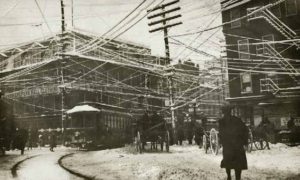When Pacific Gas & Electric (PGE) shut off electricity to more than 700,000 Californians because of predicted high winds, some homeowners thought the solar panels they installed on their roofs would keep the lights on.
They were sorely mistaken. Which is why some in Colorado are taking a hard look at microgrid technology as a way to both decentralize electricity delivery and avoid California-style debacles due to dependence on monopolistic power utilities. But there are some hurdles to be overcome first.
PGE’s power lines were partly responsible for forest fires that killed 103 people, destroyed more than 22,000 buildings and burned 1.8 million acres last year.
The November 2018 Camp fire, the most destructive wildfire in California history, was caused by a PGE high-voltage line hanging from a nearly century-old tower that lawyers for victims of the fire say was inadequately maintained.
In response to the Camp fire, PGE filed for bankruptcy in January 2019 to protect it from liability for the fire.
This year PGE decided to implement “Public Safety Power Shutoff” protocols to prevent its equipment from being responsible for fires when predicted wind speeds and dry conditions exceeded their safety margins, resulting in a three-day shutdown affecting 738,000 customers. Power was restored fully on Oct. 12.
What many homeowners who installed solar panels were unaware of is that small-source solar generation isn’t intended for emergencies, it’s only intended to reduce the power bill by feeding power into the grid when the sun shines.
California is the leader in small-source solar generation in part because state law mandates what’s called “net metering,” which essentially makes your meter run slower or even in reverse when panels are generating and your home load is small. Small systems there are limited to less than 1 megawatt peak production.
Most commercially installed systems only feed power to the grid but do not store energy for use when the power grid fails. In California costs vary but are generally more than $12,000 for the installed system.
Storage systems that will run a house independently are much more expensive and maintenance of the batteries, which have a limited lifespan, can be a chore.
Which brings us to microgrids.
Microgrids are systems that can provide continuous, uninterrupted power to anything from an office building to a factory to a residential neighborhood. According to the Department of Energy, “A microgrid is a group of interconnected loads and distributed energy resources within clearly defined electrical boundaries that acts as a single controllable entity with respect to the grid. A microgrid can connect and disconnect from the grid to enable it to operate in both grid-connected or island-mode.”
The basic concept of a microgrid is that it can be automatically disconnected and reconnected to the utility grid as needed. Microgrids have their own power generating infrastructure, which can include anything from solar panels to windmills with energy storage to geothermal to diesel or natural gas-powered generators.
The system is designed so that the independent power sources and energy storage are large enough to supply all of the normal loads of the buildings served for some fixed period of time.
The concept is just a larger iteration of having a home emergency generator running off gasoline, diesel or natural gas that powers just your home. Very small systems are called “milligrids.”
The key to microgrid technology is smart infrastructure.
Microgrids have to both synchronize with and monitor the larger power grid but be able to adjust the sources used in real time. This requires sophisticated computer technology as well as a broadband, high-speed fiber-optic “nervous system” that allows the microgrids to talk to one another and to the main power producers in real time to keep the entire system stable.
Colorado’s rural broadband initiative has the goal of achieving 100% rural broadband coverage. Governor Polis announced in May an increase in rural coverage to 85% as of April. The Department of Local Affairs Broadband Grant program was funded for five years with a $115 million appropriation in the last legislative session to try and reach 100%.
Part of that broadband capacity however is being sought by electric utilities for high-speed communications between power producers.
At the September meeting of the State Energy Legislation Study Committee in Grand Junction, Jasen Bronec, CEO of Delta Montrose Electric Association said that up to 40% of the state’s broadband fund needs to be dedicated to fiber-optic networks for power production control.
With the ability to communicate, microgrids become a feasible way of decentralizing power production, making it more reliable and more accountable to the owners/customers.
The problem with implementing microgrids in Colorado is that it’s currently illegal. Colorado operates under a state-regulated monopoly system in which the Colorado Public Utilities Commission (PUC) grants exclusive rights to power companies to supply electricity within their area and imposes a legal obligation that they do so.

This is to prevent duplication of electrical systems, a problem faced in the early years of electric power that resulted in rat’s nests of competing overhead powerlines that were both unsightly and unsafe.
Colorado courts have ruled that this grant is a property right “that cannot be infringed upon except by constitutional due process of law.” The monopoly system “is intended to protect the interests of the public as a whole, but not designed to protect individual customers.”
“Allowing customers to pick and choose from whom they will obtain any public utility service obviously creates rather than prevents duplication,” said the Colorado Supreme Court in a 1988 case.
But microgrids are analogous to the smaller individual power producers who have been granted PUC exclusivity, just on a much smaller scale, and within the territory of the primary grid provider, which would continue to provide power to the microgrid system most of the time.
Advancing microgrids in Colorado will require legislative action to resolve the regulated monopoly issues in a way that major power producers and the PUC find acceptable.


